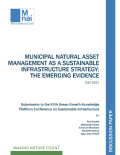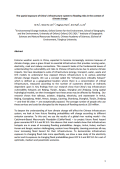
This paper documents an emerging strategy to manage natural assets such as woodlands, wetlands, and creeks in urban areas as part of a sustainable infrastructure strategy. Specifically, the paper explores Canadian local government experience through the Municipal Natural Assets Initiative (MNAI) to identify, value, and account for natural assets’ contribution to municipal government service delivery, services that would otherwise need to be delivered by engineered assets. Evidence from MNAI suggests that a structured, asset management-based approach holds great promise to tackle the twin challenges of declining urban infrastructure quality and declining ecosystem health and could have applicability well beyond Canada.

Effective flood risk management is critical to protect people and their livelihoods from flooding and to limit future losses. Nature-based measures and their ability to address flood risk are receiving increasing attention. Until recently, most flood risk management involved conventional engineering measures. These measures are sometimes referred to as “hard” engineering or “gray” infrastructure. Examples include building embankments, dams, levees, and channels to control flooding. Recently the concept of “nature-based solutions”, “ecosystem-base adaptation”, “eco-DRR” or “green infrastructure” has emerged as a good alternative or complement to traditional gray approaches. Nature-based solutions make use of natural processes and ecosystem services for functional purposes, such as decreasing flood risk or improving water quality. The objective of this document is to present five principles and implementation guidance for planning, such as evaluation, design, and implementation of nature-based solutions for flood risk management as an alternative to or complementary to conventional engineering measures.

Extreme weather events in China, expected to become increasingly common because of climate change, pose a grave threat to essential infrastructure that provides running water, electricity, road and railway connections. This research looks at the fundamental issues of understanding the vulnerability and risks to Chinese infrastructures due to adverse climate impacts. The authors have developed a suite of infrastructure (energy, transport, water, waste and ICT) models to understand how exposed China's infrastructure is to various potential climate change impacts. A concept called the “infrastructure criticality hotspot” is used which is defined as a geographical location where there is a concentration of critical infrastructure, measured according to the number of customers directly or indirectly dependent upon it. Key findings from this research show that China’s top infrastructure vulnerability hotspots are Beijing, Tianjin, Jiangsu, Shanghai and Zhejiang. Using spatial hydrological models, the authors then investigate how these areas may be affected by flooding.


